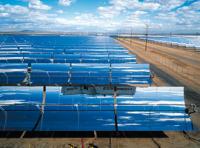 About two months ago I attended the opening of the largest “bright field” in America. While there I got the chance to meet with some representatives of SCHOTT solar the providers of the solar panels used in the field. This in turn lead to a tour of the solar cell plant. While there I started speaking with one of their representatives about solar thermal electricity.
About two months ago I attended the opening of the largest “bright field” in America. While there I got the chance to meet with some representatives of SCHOTT solar the providers of the solar panels used in the field. This in turn lead to a tour of the solar cell plant. While there I started speaking with one of their representatives about solar thermal electricity.
I got the chance to ask there CEO’s some questions about their Solar Thermal Electricity production plans. SCHOTT has been providing key components for parabolic trough collectors to collect heat and in turn produce large amounts of electricity for years now. Simple and elegant solar thermal electric generation has been an important energy production method. It will only grow in scale as people turn to renewable methods to create energy.
What follows is part one of three of the Answers they gave me.
1. What is it about the current energy market that says to SCHOTT “now is the time for solar thermal electricity?â€
a. Specifically do you think these new collectors will one day compete favorably with coal/oil/gas?
There are two key factors that have led SCHOTT to conclude that “now is the time for solar thermal electricity†in the United States and around the world.
The first is the tremendous worldwide growth being seen in demand for renewable energy.
The second is the fact that solar thermal parabolic trough power plants are a mature technology that can dependably and efficiently help communities meet their renewable energy generation goals.
To see that demand for renewable energy is growing, one need only examine the following renewable energy portfolio standards for states located in the American southwest:
- § Arizona — 15% by 2025
- § California – 33% by 2020
- § Nevada – 20% by 2015
- § New Mexico – 10% by 2011
- § Texas — 5,880 MW by 2015
In addition, a European Union (EU) commission (pdf) in 1997 set a goal for the contribution of renewable energy sources to gross inland energy consumption of 12.0% by 2010. At the European Conference for Renewable Energy in 2004 (pdf) another goal of 20% by 2020 was also set.
If these states and the EU hope to meet these goals, they will need to support renewable energy projects that can affordably and reliably generate large amounts of electricity over the next decade.
Solar thermal parabolic trough power plants fit this need perfectly. Both the International Energy Agency and the World Bank state that solar thermal power plant technology (CSP) is the most economical way to generate electricity from solar energy. [1] And over the past 20 years the solar thermal parabolic trough power plants know as the California Solar Energy Generating Stations (SEGs) have generated over 12,000 gigawatt hours of electricity.
a) Experts believe that power production costs for solar thermal parabolic trough power plants can be reduced in the next 10 years to 4-6 cents/kWh if solar thermal power capacity is expanded. These costs are comparable to the cost of producing energy from fossil fuels today.[2]
For example, The International Energy Agency (IEA) in Paris foresees a potential cost reduction to less than 6cents/kWh by 2020. And a report (pdf) prepared by the National Renewable Energy Laboratory states that, with technological improvements and increased production of solar-thermal technology and plant scale ups, parabolic trough solar systems could generate energy at a cost of 4.3 to 6.2 cents per kilowatt hour (KWh) by 2020.
 2. What is the payback time for these collectors both in terms of energy needed to create them and money?
2. What is the payback time for these collectors both in terms of energy needed to create them and money?
The energy amortization time for solar thermal parabolic trough power plants is short – experts have estimated that parabolic trough solar power systems could recover the energy used to build and operate them in as little as 5 months.[3]
In addition, solar thermal power plants use low-cost, recyclable materials that are available worldwide: steel, glass, and concrete. In addition, parabolic trough technology has the lowest material requirements of all solar thermal power plant technologies.[4]
Current estimates show solar thermal parabolic trough power plants paying for themselves after 25 to 30 years. Once they have pay for themselves, only operating costs remain, which are currently about 3 cent/KWh.
After paying off the construction costs for the power plant, the electricity generated will then be cheaper than most other energy sources, comparable to that found today from hydro power plants that have long since been written off.[5]
3. How much has efficiency increased, and how does that translate to energy production?
a. Has efficiency increased enough that you feel solar thermal is going to be more fruitful in the future than PV as a method for creating electricity?
The efficiency of parabolic trough power plants have increased dramatically since they were first introduced. Operating costs have dropped from originally 8 cents/KWh to just over 3 cent/KWh.[6]
Moreover, the energy industry’s experience working on solar thermal power plants have enabled them to develop a new generation of parabolic trough power plant technology with substantially improved performance.
For instance, SCHOTT has developed new glass and steel coatings for its PTR 70 receiver, making it more reliable and efficient than earlier models.
In addition, SCHOTT redesigned the receiver’s bellows and glass-to-metal seals so that the amount of the tube’s active area, used to capture energy from the sun, has been increased to 96%.
In addition, Acciona Solar, Inc. (formerly SolarGenix), the developer of the 64MW Nevada Solar One parabolic solar power plant in Boulder City, NV, has used computer models of parabolic troughs to find ways to lower their weight, increase their stability, reduce manufacturing costs and ease installation.
a) SCHOTT thinks it is a mistake to see solar thermal and photovoltaic power as an either/or proposition. Though both use the power of the sun to generate electricity, each technology possesses different attributes, making them complementary rather than competitive.
Moreover, given the tremendous demand for renewable energy in the United States and around the world, we think there is a large market for both technologies – which is why we produce both PV products and solar thermal power products.
 4. Due to the fact that many desert locations are very sparsely populated, and that transmission of electricity over long distances is inefficient, is it possible to use these technologies to create hydrogen as a storage medium?
4. Due to the fact that many desert locations are very sparsely populated, and that transmission of electricity over long distances is inefficient, is it possible to use these technologies to create hydrogen as a storage medium?
a. What are some other transportation strategies for getting this energy to the people that need it?
If there are methods to produce hydrogen efficiently and cheaply using electricity, and there is market for such hydrogen, there is no reason why solar thermal parabolic trough power plants could not be used to create hydrogen.
However, it is important to remember there is no need for there to be a market for hydrogen in order for the world to move forward with the development of solar thermal parabolic trough power plants. SCHOTT believes that the time for the development of solar thermal parabolic trough power plants is now.
There are currently many suitable locations for solar thermal parabolic trough power plants to be found relatively close to some of the fastest growing urban areas in the United States, such as Las Vegas and Phoenix.
a) High-voltage DC transmission is a low-loss and low-cost method that makes it possible to transmit electricity for distances of 2000 to 3000 kilometers – from North Africa to Europe, for instance.
Look for the rest of this article to come soon. While you wait you can read more about SCHOTT’s parabolic trough power plants here or download your own copy here (pdf).
[1] SCHOTT White Paper on Solar Thermal Power Plant Technology, p.26
[2] SCHOTT White Paper on Solar Thermal Power Plant Technology, p.26
[3] SCHOTT White Paper on Solar Thermal Power Plant Technology, p.21
[4] SCHOTT White Paper on Solar Thermal Power Plant Technology, p.13
[5] SCHOTT White Paper on Solar Thermal Power Plant Technology, p.26
[6] SCHOTT White Paper on Solar Thermal Power Plant Technology, p.11
Download the entire white paper here (pdf).
Read part two here.
Further information about CSP may be found at http://www.trec-uk.org.uk and http://www.trecers.net . Copies of the TRANS-CSP and MED-CSP reports commissioned by the German government may be downloaded from http://www.trec-uk.org.uk/reports.htm .
Can you tell me what the upfront cpex costs of the solar thermal power plant are, and over what time period they are to be paid back? Essentially am looking to figure out the cost structure and calculate NPV at any point of time for a solar thermal or PV plant.
Aditi: As that is a rather complicated questions I would suggest you contact schott solar directly I am sure they could give you some figures.
http://www.us.schott.com/english/index.html